

Max Davies
How Audi, BMW, Honda, Mercedes-Benz, and Suzuki started out in Australia, and where they are now
11 Hours Ago
So you want an affordable electric vehicle... Nissan was first to the party with the Leaf, but Hyundai is working hard to catch up with the Ioniq.

Contributor
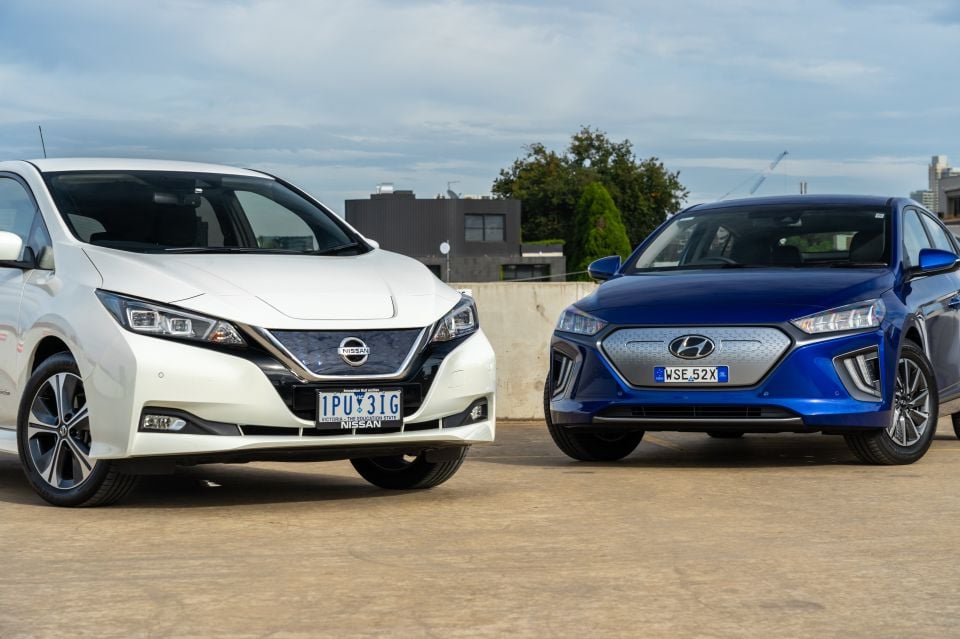

Contributor
For a long time, the Nissan Leaf was your only option if you wanted an affordable electric car.
Launched in 2010, it beat the Tesla Model S to the market by two years, and is the only electric vehicle to have survived into a second generation.
But Hyundai has invested heavily in electric vehicles, and has two pure EVs in its range.
The Ioniq Electric is still the cheapest electric car in Australia, while the Kona EV offers more range than any of its competitors.
Is the long-running standard-setter from Nissan still the affordable electric car to beat, or has the upstart Ioniq Electric Premium stolen the crown?
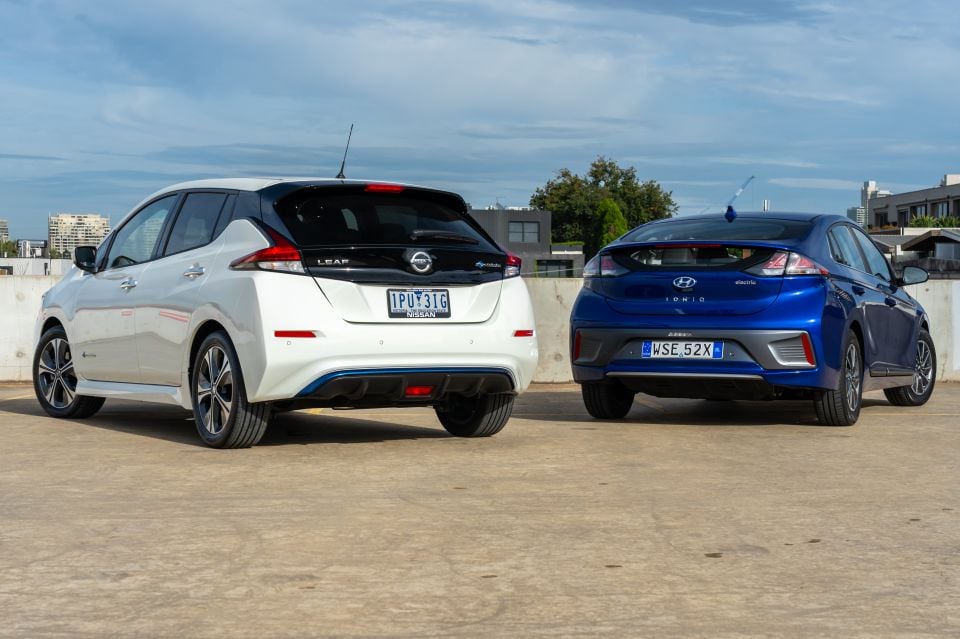
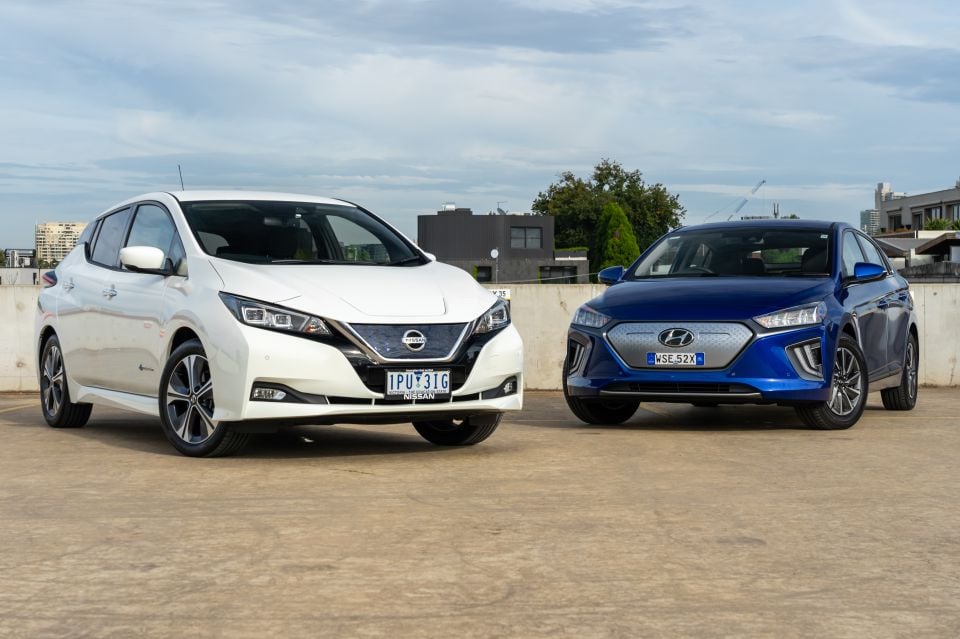
Although the Ioniq has a lower starting price than the Leaf in base Elite grade, the range-topping Ioniq Electric Premium is the more expensive of the two cars on test here.
It costs $53,010 before on-road costs, compared to $49,990 before on-roads for the Nissan Leaf.
Just one spec of Nissan Leaf is offered, and it has everything. Leather seats, seat heating for all passengers, and a heated steering wheel are standard, along with power-folding mirrors, privacy glass, LED headlamps, keyless entry and start, and automatic lights and wipers.
The dashboard is home to an 8.0-inch touchscreen infotainment system with Apple CarPlay and Android Auto – features it debuted for Nissan Australia – and the driver gets a 7.0-inch configurable display next to the analogue speedo.
The full set of semi-autonomous driver assists is standard, including autonomous emergency braking, lane-keeping assist, blind-spot monitoring, rear cross-traffic alert, lane-keeping assist, adaptive cruise control, and a surround-view camera.
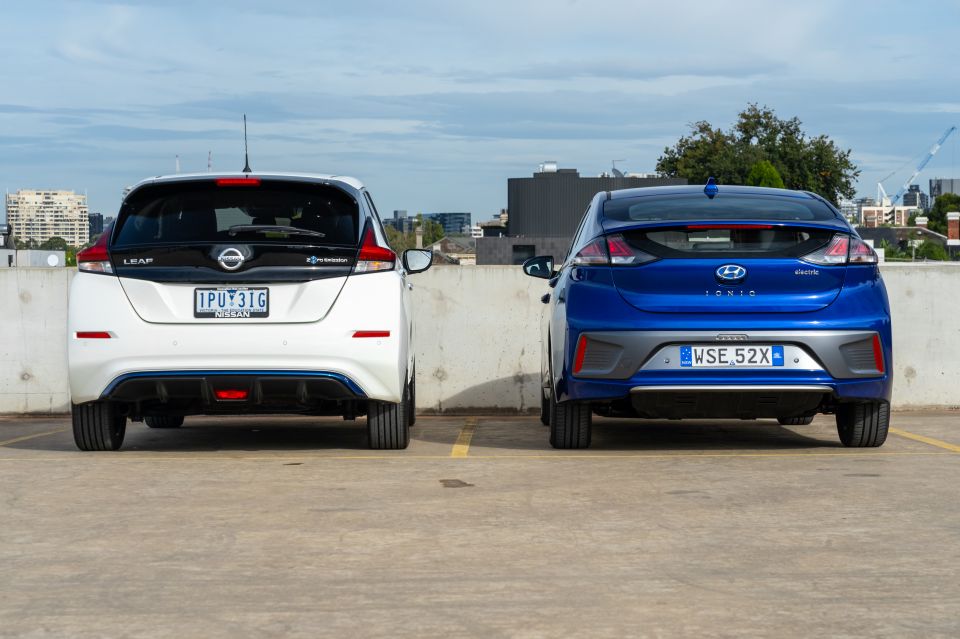
There are no options for the Leaf. What you see is what you get.
The range-topping Hyundai has a few extra features to justify its slightly higher price. Like in the Nissan, the seats are leather-trimmed and heated up front, but they’re ventilated and power-operated.
Sitting proud on the dashboard is a 10.25-inch infotainment screen, also featuring Apple CarPlay and Android Auto, and the driver is faced with a 7.0-inch digital instrument binnacle.
Along with the suite of technology offered in the Leaf, the Ioniq packs the latest Hyundai highway-speed lane following system.
Unlike the Leaf, the Ioniq has rear air vents, wireless phone charging, and a glass sunroof.
It’s more expensive, but the more generous list of standard inclusions give the Ioniq a win here.
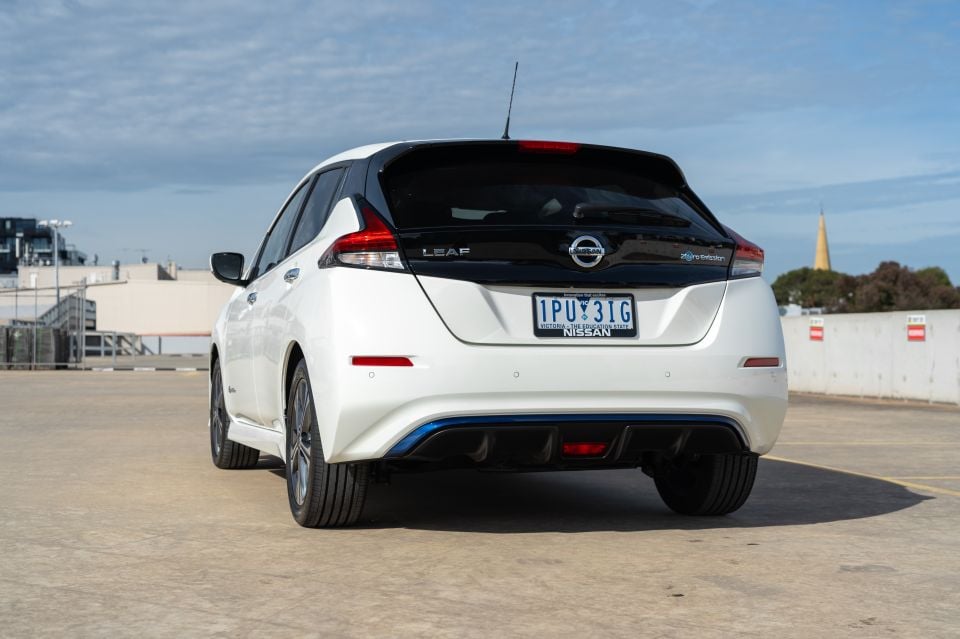
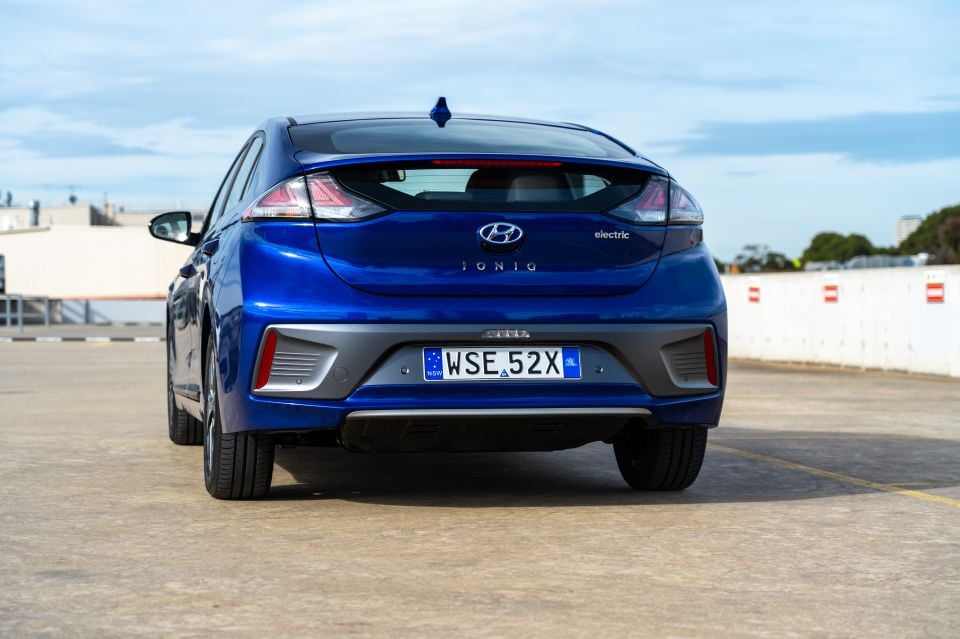
Both these cars pack a five-star ANCAP safety rating, while the Leaf has six airbags and the Ioniq has seven.
These cars also both have the same suites of semi-autonomous driver assists as well. In other words, very little to split them.
Both cars were awarded the maximum five stars by crash-tester ANCAP. The Ioniq wears a 2016 date stamp and the Leaf 2018.
| ANCAP protection score | Ioniq | Leaf |
|---|---|---|
| Adult Occupant | 90% | 93% |
| Child Occupant | 80% | 85% |
| Vulnerable Road User | 70% | 71% |
| Safety Assist | 70% | 70% |
Hyundai
The Hyundai feels properly modern inside, where the Nissan feels a bit piecemeal.
Although it only arrived in Australia late in 2018, the Ioniq has already been treated to a comprehensive interior refresh. The dashboard is now home to a 10.25-inch touchscreen infotainment system, integrated neatly into a gloss black pod with the touch-based climate controls.
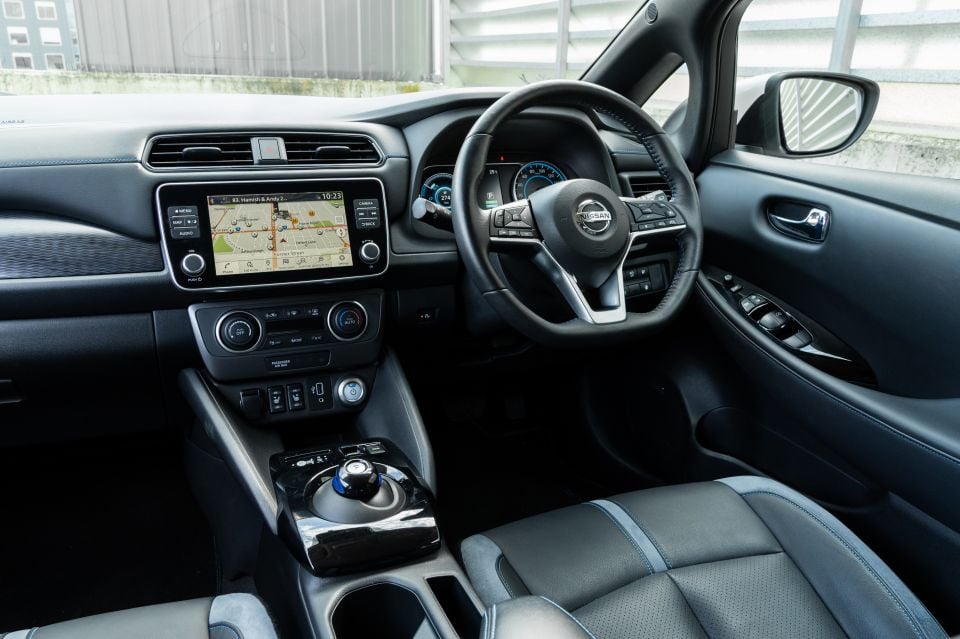
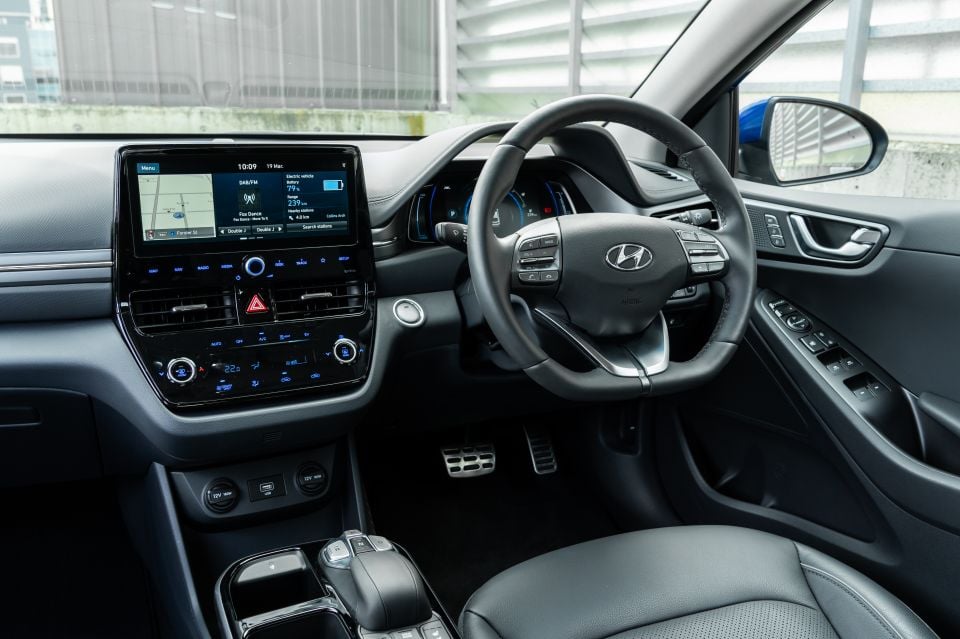
The transmission tunnel features a compact pod with transmission controls, and there’s a huge storage space below the dashboard. With no transmission, there’s no excuse to not more effectively use that space.
The screen is excellent. It’s crystal clear, quick to respond, and logically laid out with customisable tiles on the home screen. Apple CarPlay looks excellent on the widescreen display, too.
It’s the same story with the digital driver display, which is unique to the Ioniq. The semi-circular speedo display is flanked by a power meter and battery gauge, and there are unique graphics for eco, normal, and sport modes.
Nissan
Things aren’t so rosy in the Nissan. For starters, the driver sits too high. The steering wheel doesn’t adjust for reach, which just isn’t good enough, and the entire transmission tunnel is closed over.
Where the Hyundai has its climate controls neatly integrated into the infotainment pod, the Leaf has a cheap-looking setup that could’ve been nicked from a mid-spec Navara.
Where the Hyundai has a compact electric parking brake, the Leaf has a foot-operated one.
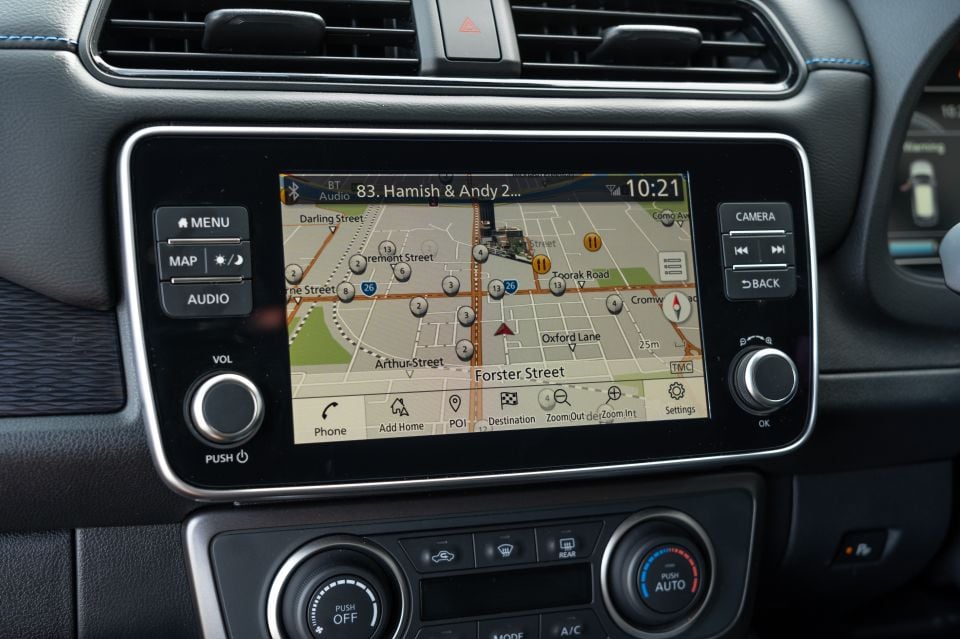
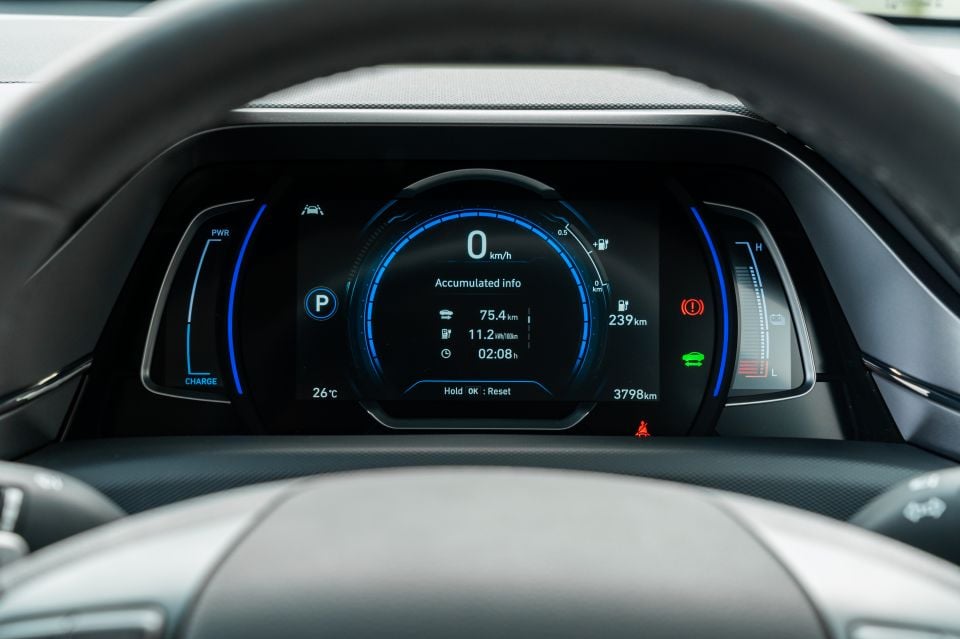
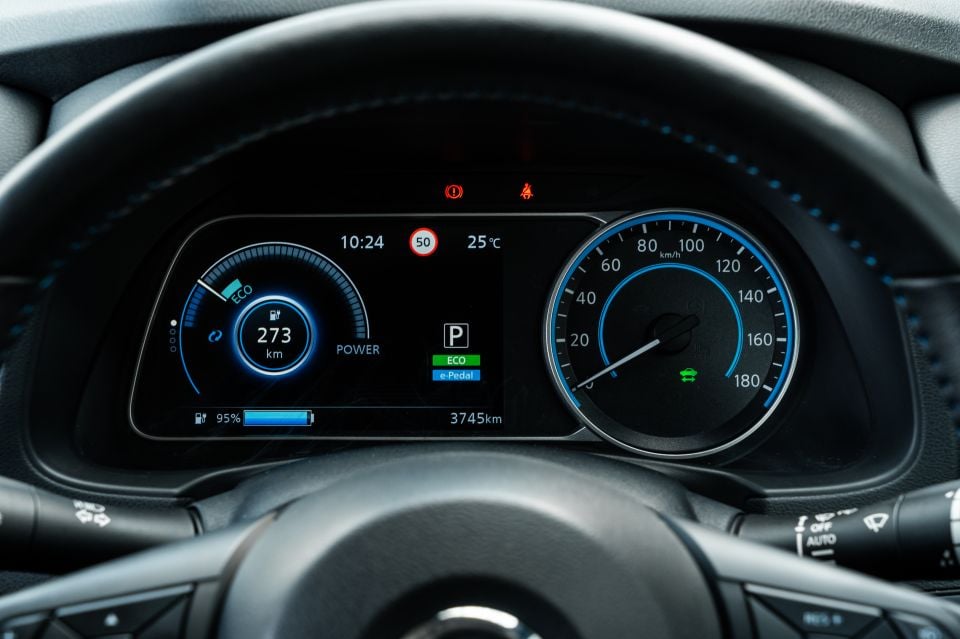
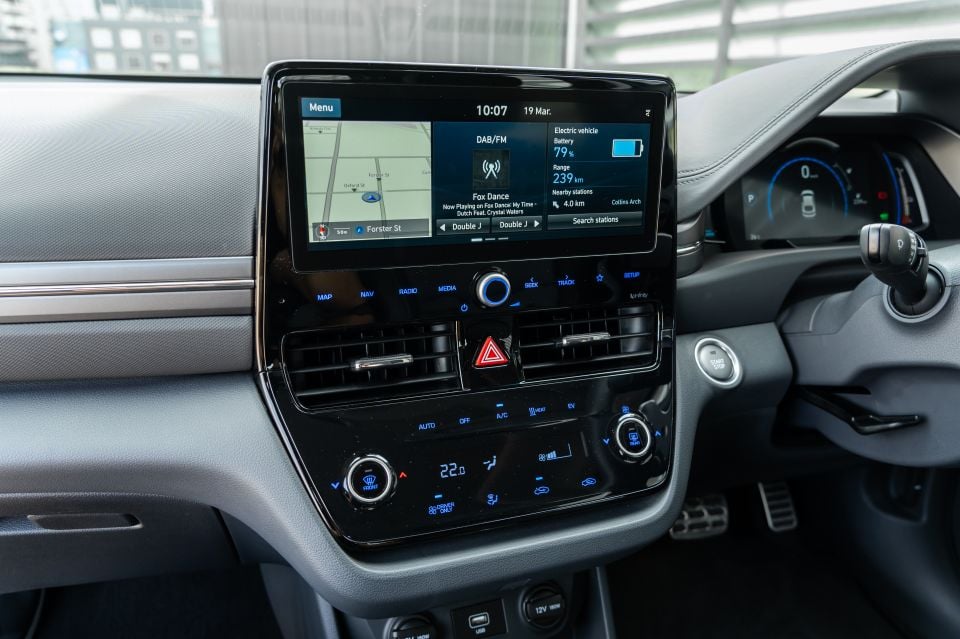
Nissan lags behind Hyundai on the technology front, too. Although the 8.0-inch screen in the Leaf is a huge step forward from the unit in the X-Trail, it still feels a generation older than the system in the Ioniq, with lower-quality graphics and a more confusing menu structure.
It’s the same story with the driver display, which just looks low-rent compared to that of its rival.
Space
Where the Leaf does assert dominance is space. The sloping roof of the Ioniq eats into rear headroom, and legroom is tight, where the larger Leaf is a more comfortable place for adults to spend time.
With 405L of space in the boot, the Leaf has 48L more luggage space to play with than the Ioniq as well.
| Ioniq | Leaf | |
|---|---|---|
| Length | 4470mm | 4490mm |
| Width | 1820mm | 1788mm |
| Height | 1475mm | 1540mm |
| Wheelbase | 2700mm | 2700mm |
| Boot space | 357L | 405L |
The Hyundai is better thought out than the Nissan from behind the wheel.
Power in the Ioniq comes from a front-mounted electric motor making 100kW and 295Nm, mated with a 38.3kWhbattery good for 311km on the tougher WLTP test cycle.
That’s an improvement of 18km on the pre-facelift Ioniq Electric, and 41km more than the 270km the Leaf claims from its 40kWh battery pack.
The Nissan makes 110kW and 320Nm from its front-mounted electric motor.
Put through their paces on a city and highway drive loop, both with air-conditioning running at 19 degrees, the Ioniq proved more energy efficient than the Leaf, using 11.1kWh/100km and 13.5kWh/100km respectively.

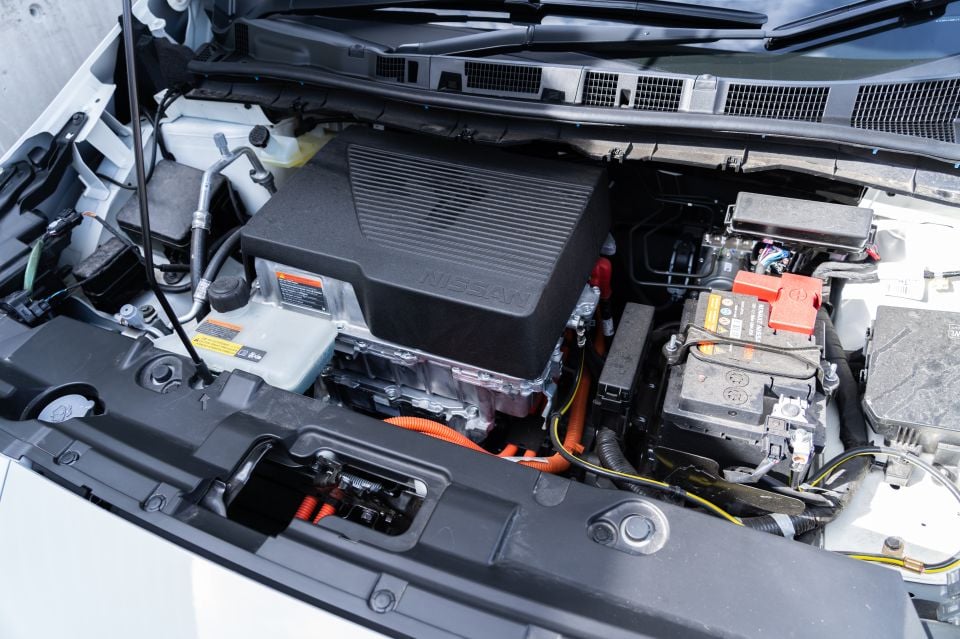
Plugged into a regular three-pin socket, you’ll be waiting around 24 hours for both these cars to charge.
A 7kW home wall box will have the Leaf juiced in under eight hours, and it accepts 50kW charging from public fast chargers.
Using a wall box, the Hyundai can charge from empty to 100 per cent in around six hours. It can also charge at 100kW using public infrastructure.
| Ioniq | Leaf | |
|---|---|---|
| Power/torque | 100kW/295Nm | 110kW/320Nm |
| Drive | Front | Front |
| Battery capacity | 38.3kWh | 40kWh |
| Range claim | 311km | 270km |
| Charge capacity | 100kW | 50kW |
| Weight | 1575kg | 1594kg |
Nissan’s experience with electric vehicles shines to the fore on the road. Even by electric standards, the Leaf is impressively smooth and quiet.
It won’t blow you away with torque off the line, but it still packs that special e-motor punch down low. With a long-travel accelerator pedal, it’s easy to precisely mete out the power.
Lift off the throttle and the e-Pedal comes into play. Essentially a fancy name for aggressive regenerative braking, it can slow the car at up to 0.2g without requiring a touch of the brake pedal.
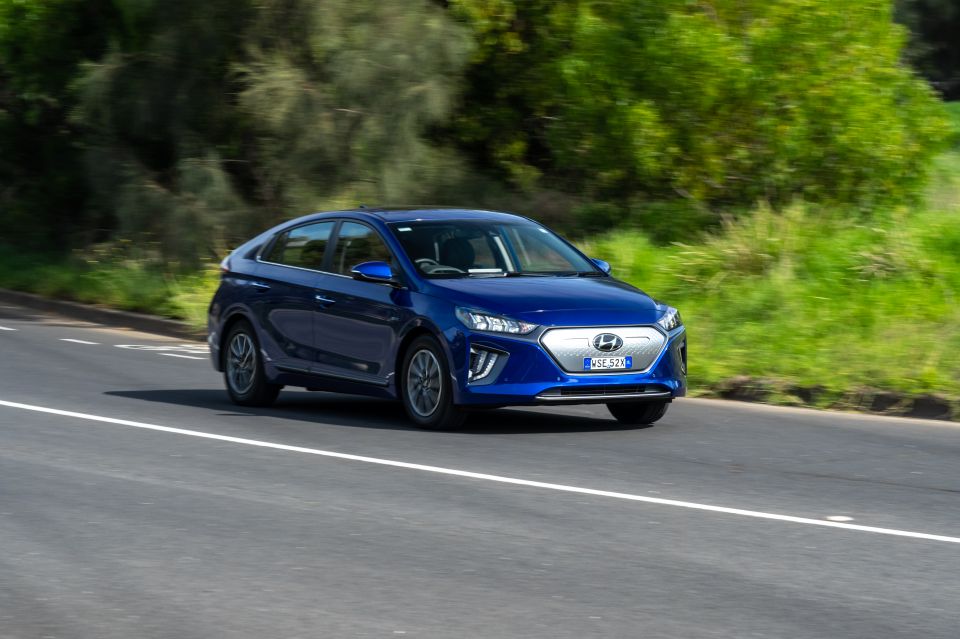
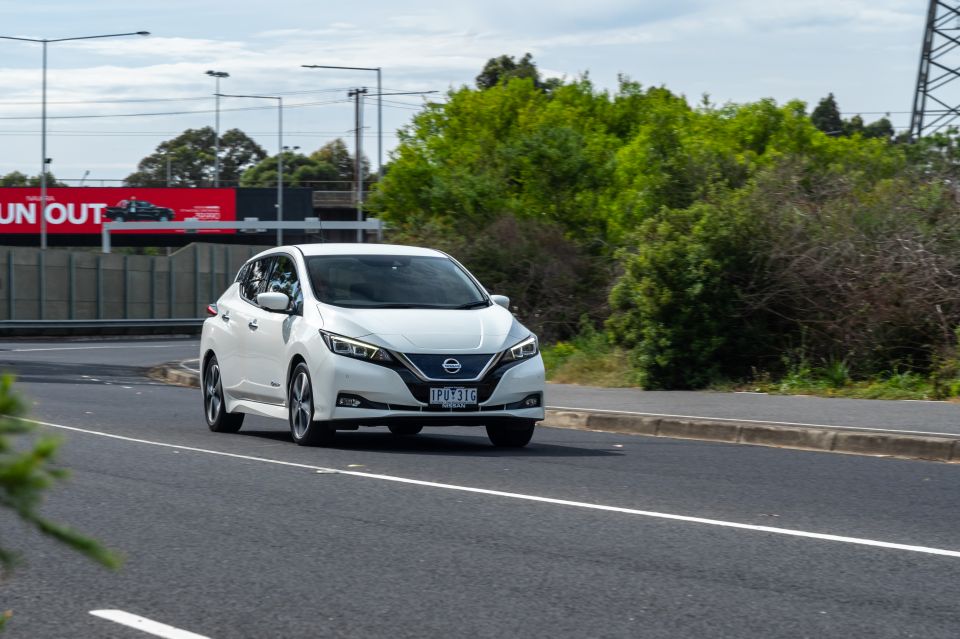
Some adjustment is required, given how different the Leaf is to a conventional internal combustion vehicle when you lift off, but the learning curve is easy to scale.
Good thing, because the brake pedal is not very good.
It’s wooden and sorely lacking in feel, and when the mechanical brakes finally do engage they’re snappy and difficult to modulate.
The Ioniq is still impressively smooth – it’s electric, after all – but doesn’t deliver its torque in quite the same silky fashion as the Nissan. The throttle is a bit touchier, and power delivery a bit more sudden.
But it’s still beautifully quiet around town, and there’s an abundance of performance on hand when you stamp the right-hand pedal anywhere below around 80km/h.
Hyundai doesn’t offer an e-Pedal like Nissan, instead allowing drivers to toggle through three different levels of regenerative braking using the paddles behind the steering wheel.
Even in its most aggressive setting, the regenerative braking doesn’t slow the car as rapidly as the system in the Leaf – it also automatically cuts out at 15km/h as well, forcing you to slow down using the brake pedal.
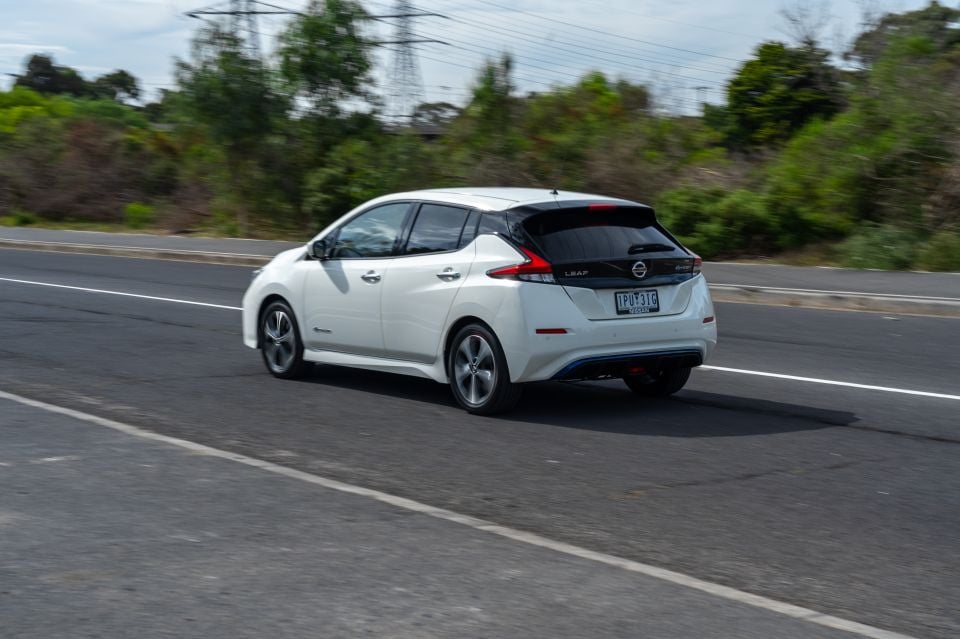

Alternatively, holding the left-hand paddle manually slows the car to a standstill with regenerative braking.
The Ioniq forces you to use a more conventional driving style than the Leaf, leaning in the direction of regular two-pedal driving.
It requires less adjustment than the Nissan if you’re new to electric vehicles, helping ease people into the plug-in world.
It’s tough to split the Leaf and Ioniq when it comes to ride quality. Both do an admirable job smoothing out the rough edges of the city, but the slightly softer Leaf is the more luxurious of the two.
Both these cars have light, direct steering and are easy to thread through skinny city streets and into tight parking spots. At highway speeds they both settle into a relaxed cruise, with settled rides and reassuring on-centre steering.
The Ioniq Electric doesn’t handle with quite the same light-footed feeling as its hybrid and plug-in hybrid siblings, but it feels the sportier of the two cars on test here.
The brake pedal is touchy and it isn’t quite as ‘sporty’, but the rest of the Nissan driving experience has the Hyundai covered.
Both these cars are backed by identical five-year, unlimited-kilometre warranties. But the Hyundai is markedly cheaper to run, thanks to its capped-price service program.
Each of the first five services costs just $160, meaning five years or 60,000km of motoring will set you back just $800.
Nissan has slightly longer service intervals, requiring maintenance every 12 months or 20,000km. But it’s significantly more expensive to maintain over the first five services, with the total maintenance bill coming to $1731 using Nissan’s capped-price service plan.
The Hyundai is cheaper to maintain by almost $1000. It takes the win here.
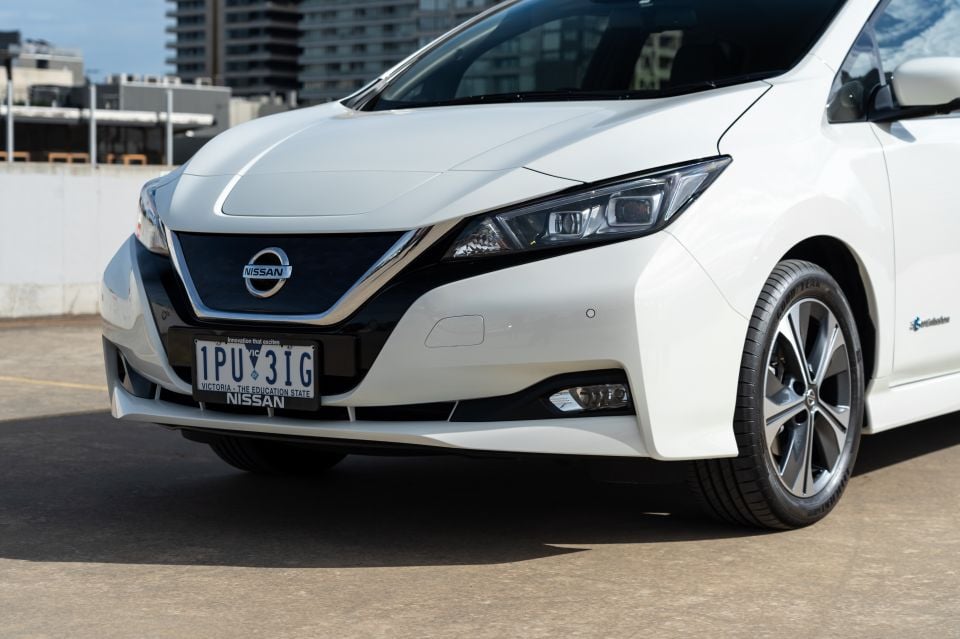
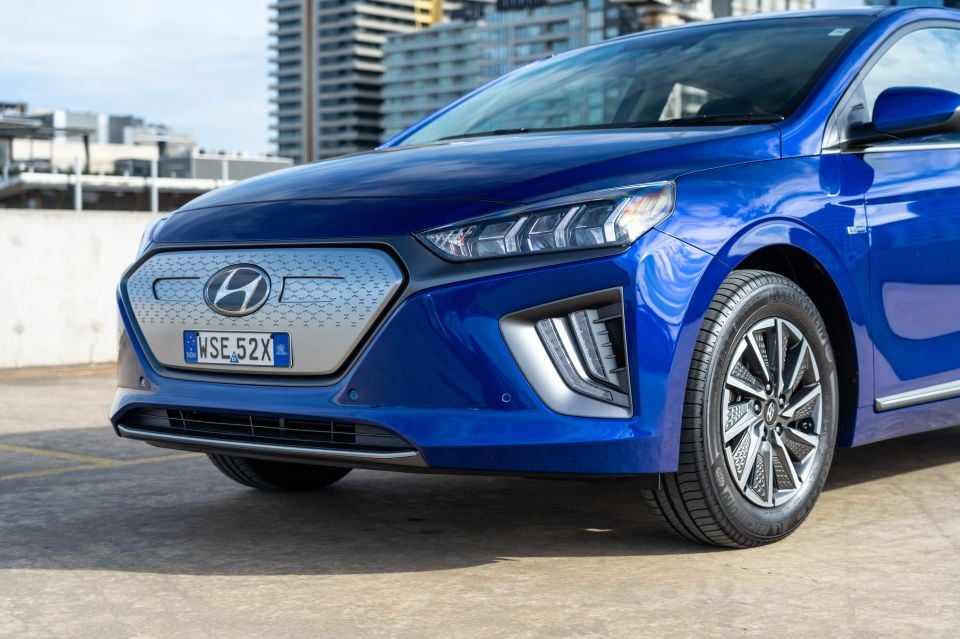
Nissan might have an electric head-start on Hyundai, but the Ioniq is the better thought-out electric vehicle.
It’s more efficient in the real world, and offers better range. It also has a far nicer interior, with more standard equipment than the Leaf to justify its slightly higher price.
It’s also significantly cheaper to maintain, one of the biggest draws of pure-electric motoring.
And although the Leaf has a more refined powertrain, the Ioniq doesn’t trail too far behind.
The Ioniq wins comfortably.
Share your thoughts with us in the comments below!
Scott Collie is an automotive journalist based in Melbourne, Australia. Scott studied journalism at RMIT University and, after a lifelong obsession with everything automotive, started covering the car industry shortly afterwards. He has a passion for travel, and is an avid Melbourne Demons supporter.
Share your thoughts and write a review of a car you own and get featured on CarExpert.


Max Davies
11 Hours Ago


William Stopford
11 Hours Ago


Derek Fung
11 Hours Ago


Max Davies
19 Hours Ago


William Stopford
1 Day Ago


Ben Zachariah
1 Day Ago